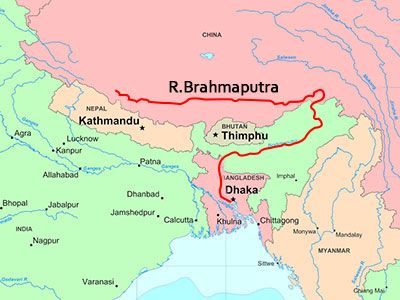The Brahmaputra Conundrum
2021 MAR 11
Mains >
International relations > India and Neighbours > water management
IN NEWS:
- China’s Parliament adopted the 14th Five-Year Plan which included a controversial hydropower project on the Brahmaputra river in Tibet close to the Arunachal Pradesh border.
BRAHMAPUTRA:
- Brahmaputra, which means "son of Brahma" in Sanskrit, is a transboundary river which flows through China, India and Bangladesh.
- It is one of the largest rivers in the world and rank fifth with respect to its average discharge.
- It has a length of 2,880 km. Of that, 1,625 km flows through the Tibetan plateau as the Yarlung Tsangpo, 918 km flows in India as the Siang, Dihang and Brahmaputra, and the rest of the 337 km in Bangladesh as Jamuna.
Course:
- The river originates from the Manasarovar Lake region, near the Mount Kailash.
- The Chinese Academy of Sciences (CAS) located the source of the river on the Angsi glacier, in the Tibetan country of Burang. The source of the river was earlier thought to be on the Chemayungdung glacier, further south.
- After flowing through Tibet, it enters India through Arunachal Pradesh and flows through Assam and Bangladesh before it joins Bay of Bengal.
- In Bangladesh, it merges with the Padma (River Ganges) and becomes the Meghna. From here, it empties into the Bay of Bengal.

SIGNIFICANCE OF BRAHMAPUTRA FOR INDIA:
- Water resource: The river Brahmaputra and its tributaries carry more than 30 per cent of the total water resource potential of India. As lower riparians, both India and Bangladesh rely on the Brahmaputra River for water, agriculture and livelihoods.
- Economic significance: The Brahmaputra is subject to frequent shifting of its course, thereby creating fertile land. Also, 625 million people live in the Brahmaputra basin, of which 80% are farmers who rely almost exclusively on the river for irrigation. Besides these, the river is a major transport route and an important source for inland fisheries.
- Meet its ambitious plans: The Brahmaputra is an important resource for India’s own water diversion plans — the national river interlinking project — and is considered a powerhouse to meet India’s energy demands in the future.
- Disaster management: The Brahmaputra basin is among the most flood prone areas in India. Given the large population density and under development in the region, management of the river is crucial for India to enhance its disaster risk resilience.
- Ecological: The Brahmaputra river system and its delta are one of the world’s most ecologically sensitive regions. Eg: The river is home to the critically endangered Gangetic river dolphin and its river basin houses several protected areas, like the Kaziranga and Manas National Parks.
- Cultural: Brahmaputra is revered by Hindus, Jains and Buddhists. For eg: To the Hindus, the Brahmaputra was the son of Brahma and Amogha.
- Strategic: The river is a major route facilitating troop movements to the North Eastern borders of India. To realise this full potential, India has been undertaking large scale infrastructure development across the river, such as the Bhupan Hasarike and Bogibeel bridges.
INDIA’S GEOPOLITICAL CONCERNS OVER BRAHMAPUTRA:
- China’s ‘Water bomb’: China has unilaterally developed hydraulic infrastructure on the river without the consent of lower riparian nation-states. Hence, there is the threat that during a conflict or a border dispute, China may decide to stop the flow of the river as a means of retaliation to make India submit to China's demands.
- China’s economic imperialism: In South Asia, China has been insistent in reaching deals that favours its economic expansionism. For eg: In 2015, China signed the Lancang-Mekong Cooperation (LMC), an alternative to the Asian Development Bank-led Mekong River Commission. The LMC aligns with China’s Belt and Road Initiative and focuses on land and water connectivity, besides river management. Reaching a similar deal over Brahmaputra could be against Indian interests.
- Geopolitical encirclement: India and Bangladesh have a stressed relationship over Teesta river, whereas China is cooperating more with Bangladesh on flood forecasting, water technologies, and water management. Through this, China could well be aiming to encircle India.
- Weak agreements: The Brahmaputra agreement between China and India is a suboptimal arrangement within broader bilateral relations. The weakness of the MoU was exemplified when China temporarily stopped data sharing over the high season flows as per the China-India MoU during the Doklam standoff.
- Ecological concerns: China's continued construction activities in the Himalayas pose an ecological risk as well. The Brahmaputra basin is one of the world's most ecologically sensitive zones. The sheer size of the Chinese projects poses a grave environmental risk to the millions of people and several other species living downstream.
- Climate change: Besides the Chinese risk, climate change is leading to variable rainfall, fluctuating river regimes and increased sedimentation into the river. Such changes in the river can cause lead to river water disputes in the future, resulting in substantial harm for downstream livelihood and economies of all the riparian countries.
WAY FORWARD:
- Firm stand: India needs to mirror its strength and firmness in negotiations with China on water rights, as it did in the case of the Doklam stand-off and in opposing the Belt and Road Initiative.
- Create a strong treaty: A strong bilateral treaty with China on Brahmaputra water, much in the line of Indus water treaty, is necessary for India. If necessary, the international community should also be involved.
- Strengthen relations with Bangladesh: It needs to de-emphasise China’s role for the time being and restrengthen its relationship with Bangladesh. It needs to push the impending Teesta river agreement and restore its image as a responsible upper riparian.
- Develop hard infrastructure: India needs to step up its pace of developing water storing infrastructure to counter the Chinese ‘waterbomb’ strategy, and at the same time, address the growing water stress in the country.
PRACTICE QUESTION:
Q. The Brahmaputra river holds a unique place in India-China relationship. Elaborate?
